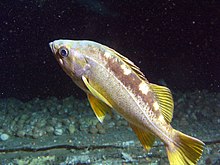Yellowtail rockfish
This article includes a list of references, related reading or external links, but its sources remain unclear because it lacks inline citations. (February 2021) |
| Yellowtail rockfish | |
|---|---|

| |
| Scientific classification | |
| Kingdom: | Animalia |
| Phylum: | Chordata |
| Class: | Actinopterygii |
| Order: | Scorpaeniformes |
| Family: | Sebastidae |
| Genus: | Sebastes |
| Species: | S. flavidus
|
| Binomial name | |
| Sebastes flavidus (Ayres, 1862)
| |
Sebastes flavidus, the yellow tail rockfish, is a type of rockfish (Sebastidae) that lives mainly off the coast of western North America from California to Alaska. This fish is also commonly called yellowtail rockfish or yellowtail seaperch.
Description[]
The body of the yellowtail rockfish is elongate and compressed. The head is rather long and the upper profile is steep and slightly curved. The lower jaw projects, but not beyond the upper profile of the head. The color is grayish brown above which shades to white below. The sides are finely spotted with yellow. The tail is yellow, while the other fins are dusky yellow. When the fish is fresh, reddish brown speckling is visible on some of the scales. As with many of the rockfish, identification can be somewhat difficult. Some of the distinguishing characteristics of the yellow tail rockfish include a convex (surface curves outward) space between the eyes, the absence of spines on top of the head, a projecting lower jaw, an anal fin with eight (rarely seven) soft rays and the lining of the belly is white.
Range[]
The yellowtail rockfish occurs from San Diego, California, to Kodiak Island, Alaska; it is caught commercially off the coast of British Columbia, as well as being caught by recreational anglers off of central and northern California. It is regularly found over deep reefs from the surface to depths of 1,800 feet.
Natural history[]
Adult yellowtail rockfish feed on small hake, anchovies, lanternfish, and other small fishes, as well as on small squid, and other shrimp-like organisms. These are all good baits to use for the yellowtail rockfish. A few yellowtail rockfish mature when 11 inches long or 3 years old. Fifty percent are mature when 13 inches long or 5 years old. They may live to be 24 years old. As with other rockfishes, fertilization is internal and live young are born. The number of developing eggs increases from 50,000 in a fish 12 inches long to about 633,000 in a fish 19 to 21 inches long.
Genetics[]
A potential PCR-RFLP genetic sex marker developed for gopher rockfish[1] does not successfully distinguish male and female yellowtail rockfish.[2]
Fishing information[]
When fishing for yellowtail rockfish in deeper waters, the typical rockfish rig and bait is appropriate. Since this species occurs quite often at or near the surface, standard surface fishing techniques and baits such as anchovies or squid fished on a small hook are effective. Small silvery lures or small lead and rubber jigs also work well.[citation needed]
Status[]
Separate stock assessments for yellowtail rockfish in the waters off British Columbia, and the West Coast of the United States north of Cape Mendocino have estimated the stock as healthy (above the management limits) with overfishing not occurring.[3][4] Yellowtail rockfish in the Gulf of Alaska were included in an "Other Rockfish" stock complex which was also estimated as not experiencing overfishing.[5] The stock of yellowtail rockfish south of Cape Mendocino are estimated to be genetically distinct from those further north, but insufficient information was available to estimate the status of the stock in this area.[3]
References[]
- ^ Fowler, Benjamin L.S.; Buonaccorsi, Vincent P. (2016). "Genomic characterization of sex‐identification markers in Sebastes carnatus and Sebastes chrysomelas rockfishes". Molecular Ecology. 25 (10): 2165–2175. doi:10.1111/mec.13594.
- ^ Vaux, Felix; Aycock, Hannah M.; Bohn, Sandra; Rasmuson, Leif K.; O'Malley, Kathleen G. (2020). "Sex identification PCR–RFLP assay tested in eight species of Sebastes rockfish". Conservation Genetics Resources. 12: 541–544. doi:10.1007/s12686-020-01150-y.
- ^ Jump up to: a b Stephens A, Taylor IG (2018), Status of Yellowtail Rockfish (Sebastes flavidus) Along the U.S. Pacific Coast in 2017 (PDF), Portland, OR: Pacific Fishery Management Council
- ^ Fisheries and Oceans Canada (2015), Yellowtail Rockfish (Sebastes flavidus) Stock Assessment for the Coast of British Columbia, Canada (PDF), Canadian Science Advisory Secretariat Pacific Region Science Advisory Report 2015/010
- ^ Tribuzio CA, Echave KB (2016), Assessment of the Other Rockfish stock complex in the Gulf of Alaska (PDF), Anchorage, AK: North Pacific Fishery Management Council
External links[]
- The initial version of this article was copied from California Marine Sportfish by the California Department of Fish and Game, Marine Region; a public domain resource.
- EOL.org
- itis.gov
- Sebastes
- Taxa named by William Orville Ayres
- Fish described in 1862